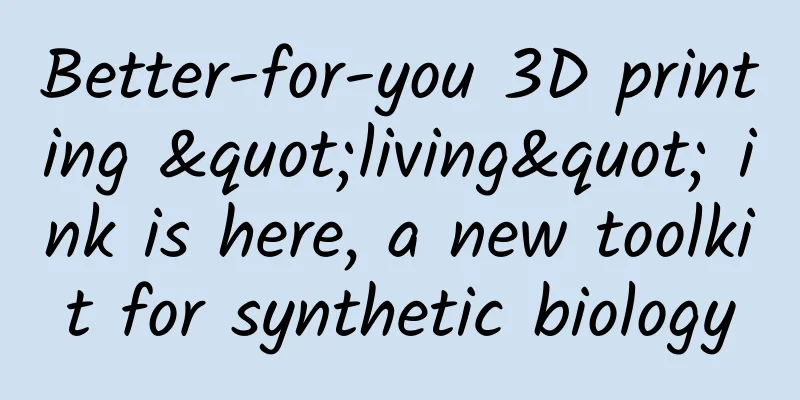Better-for-you 3D printing "living" ink is here, a new toolkit for synthetic biology

|
The concept of 3D printing technology has become popular since it was first "born out of nowhere". Now it has not only received widespread attention in the field of scientific research, but has also begun to take shape in the industrial field. There are many specific applications of 3D printing in the manufacturing industries such as automobiles, aerospace, and military, as well as in many industries such as medical care, cultural creation, and education. The molding materials are basically metal or non-metal, and are mainly in powder, wire, and liquid form. As 3D printing technology and the market mature, its intersection with computer graphics, robotics, life sciences, materials science and other fields has become more extensive, and the degree of multidisciplinary integration has gradually deepened, which has also provided 3D printing with more possibilities and broad development prospects. 3D bioprinting has evolved from the additive manufacturing process of 3D printing to build materials layer by layer and finally form products. It can produce 3D tissue structures with similar tissue complexity that can be precisely controlled. The key to this technology lies in the printing materials, which also inherits the high requirements of 3D printing for materials. No longer the metal or non-metal in the past, the materials used in 3D bioprinting include living cells and biological materials, generally referred to as "bio-ink". As a printing material, bio-ink must first have good biological activity, similar to the extracellular matrix in the body, so that cells can further develop and establish intercellular connections after printing. Secondly, it is required to have good formability, good fluidity during printing, and be able to solidify quickly after printing. At present, some progress has been made in the use of microbial engineering to produce materials for various applications, but constructing three-dimensional structures in arbitrary patterns and shapes has always been a great challenge. Recently, students from Harvard University's John Paulson School of Engineering and Applied Sciences, Wyss Institute for Biologically Inspired Engineering, School of Medicine and Engineering, and Northeastern University's Department of Chemistry and Chemical Biology completed a study on bio-inks. Their research combines advanced nanobiotechnology with active material technology, opening up new space for 3D bioprinting technology to produce functional "living organisms". This research was also published in Nature Communications, a subsidiary of Nature magazine. Taking advantage of the genetic programmability of microorganisms Living cells have the ability to synthesize molecular components and assemble them precisely at the nanoscale, thus building macroscopic living functional structures under appropriate environmental conditions. Anna and Avinash from Harvard University led their research team to develop a printing material they called "microbial ink". It is made entirely of genetically engineered microbial cells, and is programmed to self-assemble protein monomers into nanofibers from bottom to top, and further form a nanofiber network containing extrudable hydrogels. By embedding genetically engineered Escherichia coli (E. coli) cells and nanofibers into microbial ink, the researchers further demonstrated the 3D printing technology of functional biomaterials to the outside world; this technology can effectively isolate toxic parts, release biological agents, and regulate the growth of their own cells through chemical induction through rationally designed genetic material. In fact, 3D bioprinting is relatively mature in the context of tissue engineering, and has recently been used to print microbial cells needed in the fields of biotechnology and biomedicine. However, the inkjet printing, contact printing, screen printing, and lithographic printing technologies that have been explored today are slightly less compatible and cost-effective than extrusion-based bioprinting technologies. Therefore, there are many methodological research methods under this concept, and many types of bio-inks have been explored. But to date, no one has fully exploited the genetic programmability of microorganisms to rationally control the mechanical properties of bioinks. The researchers believe that for a variety of reasons, this idea could advance sustainable manufacturing practices, the production of raw materials in resource-poor environments (like some barren lands or alien universes), and the enhancement of material properties through the precision of biomimetic design and genetic engineering. This is what inspired Anna and Avinash to conduct this project. Their vision for the ultimate goal is divided into three stages. The first is to design an extrudable bio-ink with high printing fidelity; then to produce this bio-ink entirely from engineered microorganisms through a "bottom-up" approach; and finally, to create a programmable platform to achieve advanced functions of 3D printed living structures at a larger and more macroscopic level, thereby pushing the emerging field of living materials into an untapped frontier technology blue ocean. Using genetic engineering In this work, they made a microbial ink made entirely from genetically engineered E. coli biofilms. In the paper, they detailed the specific characteristics of this microbial ink, demonstrating the integrity of its structure and shape. The more long-term impact is that by embedding genetically engineered Escherichia coli cells into microbial inks, they demonstrated the possibility of 3D printing a variety of potential bio-inks, such as therapeutic biomaterials, isolation biomaterials, and adjustable biomaterials. Figure | Schematic diagram of the design strategy, production and functional application of microbial ink (Source: Nature Communications) In part a of the figure, the researchers genetically engineered Escherichia coli to produce microbial ink by combining the α (knob) and γ (hole) protein domains derived from fibrin with CsgA, the main structural component of the curly nanofibers. After secretion, CsgA-α and CsgA-γ monomers self-assemble into cross-linked nanofibers through globular-pore binding interactions. (b) shows that the knob and pore domains are derived from fibrin, which play a key role in the supramolecular polymerization process of blood clot formation. (c) shows the entire scheme for producing microbial inks from engineered protein nanofibers, involving standard bacterial culture, limited processing steps, and no need to add exogenous polymers. Finally, the microbial inks were 3D printed to obtain functional biomaterials. The idea of this design is based on the research team's earlier work. Anna and Avinash previously demonstrated that native protein curled nanofibers of the E. coli biofilm extracellular matrix (ECM) can be genetically engineered by fusing functional peptides/proteins to the curled CsgA monomers to produce shear-thinning hydrogels. At the same time, in order to create a bio-ink with ideal viscoelasticity, they introduced a genetically engineered cross-linking strategy inspired by fibrin (shown in the part of Figure b above). The microbial ink prepared in this study reuses the binding interaction between alpha and gamma modules, namely the "knob-hole" interaction, and introduces non-covalent cross-linking between nanofibers to enhance mechanical robustness while maintaining shear thinning performance. In addition, the researchers said that it is also worth noting that the fibers formed by CsgA self-assembly are highly stable and can resist proteolysis, detergent-induced and thermal denaturation. New tools for synthetic biology Printable bio-inks need to have a viscosity low enough to be easily extrudable, yet strong enough to retain their shape after printing. This achievement has greatly promoted the development of advanced bio-inks with adjustable mechanical strength, high cell viability and high printing fidelity in the field of 3D bioprinting technology, and expanded research thinking. In their view, in the future, using the "toolkit" of biological parts developed by synthetic biologists that can continue to grow, microbial inks can be further customized for various biotechnology and biomedical applications. Especially when it is necessary to combine with other material technologies, such as those that have incorporated living cells into structural building materials, the microbial bio-inks prepared by the institute will be particularly important. In addition, it can also support the construction of structures in human habitats in extreme environments such as space; because the transportation of raw materials in such environments is extremely difficult, the on-demand generation of building materials from very limited resources must be considered. Overall, 3D bioprinting is still in the initial research and development stage. Bio-ink, as a key material in the biological 3D printing technology, is also a research focus in this field. For market applications, it is too early to talk about the scale and marketization of these technologies. However, this research field has great potential for future development and can be applied in a wide range of areas, including personalized medical devices, research and development of new biomaterials, three-dimensional scaffolds and three-dimensional cell culture, regenerative medicine, construction of multicellular biological structures, and the building materials envisioned by the researchers in this article. It can be said that biological 3D printing technology is developing at a very fast pace, and it has greatly benefited various fields such as surgery and regenerative medicine. In the future, let us look forward to the emergence of more technologies in this field that can improve human society and transform related industries. References: https://www.rs-online.com/designspark/home https://ethz.ch/en/news-and-events/eth-news/news/2017/12/3d-printed-minifactories.html https://www.sciencedaily.com/releases/2017/12/171201181555.htm Written by: Yang Qi Editor: HS Layout: Li Xuewei |
<<: This is cauliflower, this is not cauliflower, netizens: I just want to know if I can eat it
>>: "Zero Altitude House" allows you to conquer the Qinghai-Tibet Plateau
Recommend
Xiaohongshu promotion methods and tips to become popular!
Xiaohongshu is a core platform in online marketin...
Meizu 20 Pro review: Two years of hard work, a full-on "alien" flagship
For the mobile phone market and consumers, the Me...
How to do content marketing without money? Can you do it?
"No money", "No budget"... ar...
The wind is blowing, but it is the two-wheeled electric vehicles that are blowing
To learn to fly, you must first learn to walk. Wh...
A "paper airplane" that can be folded in one hour destroyed a fighter jet worth $100 million...
These paper airplanes that look like children'...
E-commerce operations: 50 Taobao brand marketing notes
Taobao was born in 2003. The first batch of “Taob...
AfterShokz bone conduction headphones
Because I love running, I have been looking for v...
2014~2016 The most powerful summary of H5, global H5 development...
To summarize the popular H5 cases from 2014 to 20...
The latest news on Shanghai’s closure period in 2022: How many days will the closure last? When will the epidemic end and things return to normal?
Recently, new cases have appeared in Jilin, Changc...
Shanghai has 1 new confirmed case imported from the United States! What is the specific situation? Also attached is the latest national epidemic situation!
Currently, the United States is the country with ...
Here are all the contents related to China in the report of the Queen of Internet
On the morning of June 2, Mary Meeker, known as t...
C4D+Octane+PS [E-commerce product required course teaching collection]
C4D+Octane+PS [E-commerce Product Compulsory Cours...
It was revealed that the GPRS encryption algorithm used in early mobile phones was deliberately weakened
[[406364]] A team of researchers from several Eur...
Which one should I buy, quantum dot TV or OLED TV?
I want to buy a TV recently, but some people say t...









